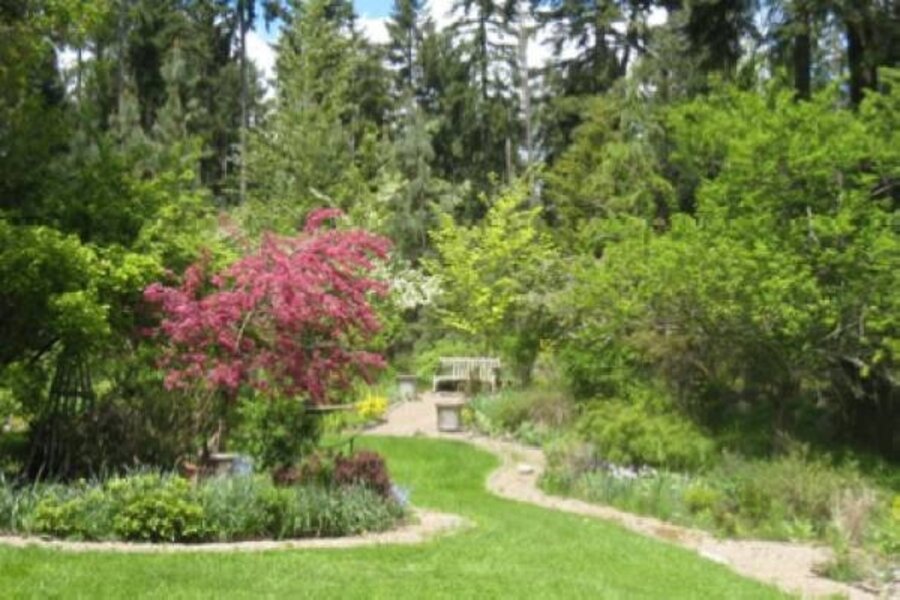Got too much lawn?
Loading...
Lawns are the No. 1 user of water in the garden. There’s a big movement to tear out those thirsty, high-maintenance, gas guzzling, chemical-sucking parts of the landscape. But wait — folks love their lawns, yes, we do. So here’s a guide to know when to just say no to a lawn.
You know you got too much lawn when: The only footsteps it receives are the ones behind a mower.
Ask yourself: What does my lawn do? If it’s a play place for kids or adults — or in our case, a border collie with a Frisbee fetish — you need it. No other natural surface will suffice.
However, newer easy-care grasses are being developed all the time, so consider overseeding this fall with a new turf grass suitable for your part of the country. (Your local extension office has the latest info.) Or, depending on where you live, consider a whole new lawn grass, such as deeply-rooted native buffalo grass.
If your lawn simply functions as a design element, giving you that green and calming respite between the glories of your flowering borders, try an eco-lawn mix or low-growing plants that take some footsteps, but much less water, such as tiny-leafed thyme.
You know you got too much lawn when: Your chemical bill at the nursery is higher than your kid’s college tuition.
Let’s face it — the goal of a perfect green expanse was a triumph of advertising. According to Virginia Scott Jenkins’ book "The Lawn — A History of an American Obsession," left over from World War II. You can’t make perfection without chemicals, as the Sunset headquarters in Menlo Park, Calif., proved when they converted to all organic. Their Thomas Church-designed bent-grass lawn doesn’t look quite so buff.
But if a home-and-garden icon like Sunset can do it, you can, too. The secret is to lower your expectations. For broad-leaf weeds, a quick once-over with that handy tool I’ve dubbed “the Ponker” keeps the uglies at bay. Press down, rock back, and it grabs weeds (and roots). And celebrate diversity with clover — it fixes nitrogen in the soil, allowing the grass to use it.
You know you got too much lawn when: All your yard waste is grass clippings. Remove your mower's grass catcher to save time and money.
When we used a mulching blade and left the clippings in place, my husband discovered that our grass stayed greener longer, with less stress — thus necessitating less water.
If you need more green, consider low-numbered organic fertilizers. My favorite is cottonseed meal, which worked so well when I recommended it to a friend, he came back with the complaint, “You didn’t tell me I’d have to mow more.”
You know you got too much lawn when: Your 3 a.m. insomnia is about water — either bills or municipal restrictions.
Perhaps brown in a lawn is not a color you can live with. Consider the possibilities of substituting handsome hardscaping that will add a tremendous value in curb appeal. Keep water-wise plantings — maybe in raised beds — to frame your house.
You know you got too much lawn when: All your gardening time is spent grooming grass.
Even if you have never considered yourself “the gardener in the family,” as so many homeowners who mow have told me they’re not, there’s a whole world out there of amazing plants to grow. You can enjoy bringing your own home-grown food to the table, or the magical evening scents of flowering tobacco, lilies, and night-blooming jasmine opening on sweet late-summer evenings.
No expanse of little green stubbles can give you that.
So play on your lawn, party on your lawn, and throw Frisbees to your dog’s heart’s content. For anything else, a lawn proxy can be very rewarding.
Mary-Kate Mackey, co-author of Sunset’s Secret Gardens — 153 Design Tips from the Pros and contributor to the Sunset Western Garden Book, writes a monthly column for the Hartley Greenhouse webpage and numerous articles for Fine Gardening, Sunset, and other magazines. She teaches at the University of Oregon’s School of Journalism & Communication. She will be writing about water in the garden for Diggin' It.
Editor’s note: To read more by Mary-Kate, check our blog archive. Gardening articles on a variety of topics can be found at the Monitor’s main gardening page. Also see our RSS feed. You may want to visit Gardening With the Monitor on Flickr. Take part in the discussions and get answers to your gardening questions. If you join the group (it’s free), you can upload your garden photos and enter our next contest. We’ll be looking for photographs of fruits. So find your best shots of summer’s blueberries, peaches, plums, etc., and get out your camera to take some stunning shots of early fall apples. Post them before Sept. 30, 2009, and you could be the next winner.






